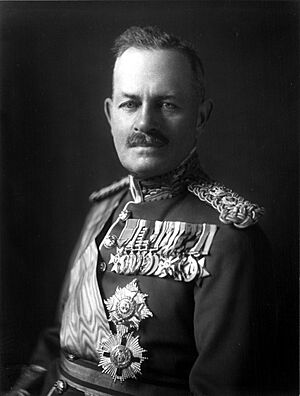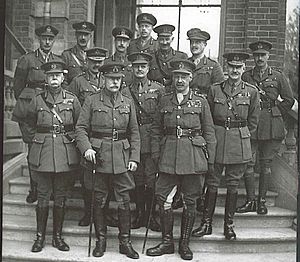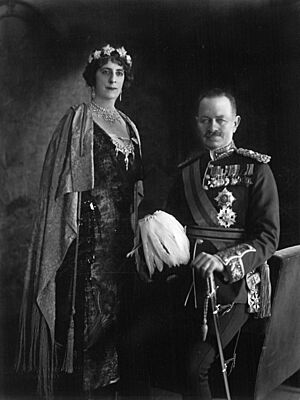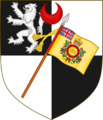Julian Byng, 1st Viscount Byng of Vimy facts for kids
Quick facts for kids
The Viscount Byng of Vimy
|
|
|---|---|

Byng in 1921
|
|
| 12th Governor General of Canada | |
| In office 2 August 1921 – 5 August 1926 |
|
| Monarch | George V |
| Prime Minister | |
| Preceded by | The Duke of Devonshire |
| Succeeded by | The Viscount Willingdon |
| More... | |
| Personal details | |
| Born |
Julian Hedworth George Byng
11 September 1862 Wrotham Park, Hertfordshire, England |
| Died | 6 June 1935 (aged 72) Thorpe Hall, Essex, England |
| Spouse | Marie Evelyn Moreton |
| Profession | Officer |
| Signature | |
| Military career | |
| Allegiance | United Kingdom |
| Service/ |
British Army |
| Years of service | 1879–1919 |
| Rank | Field Marshal |
| Commands held |
|
| Battles/wars | |
| Awards | |
Field Marshal Julian Hedworth George Byng, 1st Viscount Byng of Vimy (1862–1935) was a British Army officer. He served as the Governor General of Canada, the 12th since Canada became a country.
Friends called him "Bungo." Byng was born into a noble family in England. He went to Eton College. After school, he joined the military. He served in Egypt and Sudan. He also fought with distinction in the First World War. He commanded the Canadian Corps at the famous Battle of Vimy Ridge.
In 1921, King George V appointed him Governor General of Canada. He was very popular with Canadians. During his time, his actions in a political event called the "King-Byng Affair" led to big changes. These changes affected the role of the King's representative in countries like Canada. After his time in Canada, Byng returned to the UK. He became the police chief in London. He was promoted to Field Marshal before he died in 1935.
Contents
Early Life and School Days
Julian Byng was born at Wrotham Park in England. He was the 13th and youngest child in his family. His father was George Byng, 2nd Earl of Strafford.
Byng went to Eton College until he was 17. He got the nickname "Bungo" there. This helped tell him apart from his older brothers. He wasn't a great student. He once traded his Latin book for ferrets and a pineapple! He later said he was the school's worst "Scug," meaning an ordinary boy.
Starting a Military Career
Byng came from a military family. His grandfather fought with Wellington at the Battle of Waterloo. At 17, Byng joined the militia. This was a local army group. He became a second lieutenant in 1879. He was promoted to lieutenant in 1881.
In 1882, the Prince of Wales (who later became King Edward VII) offered Byng a spot in his own regiment. This was the 10th Royal Hussars. It was a very expensive regiment. Byng's father could not pay for it all. But Byng was clever. He bought polo ponies cheaply. He trained them well and sold them for a profit. This helped him afford to join the Hussars in 1883. He then went to India with his regiment.
In 1884, his regiment went to Sudan. Byng fought in the Battles of El Teb and the Battle of Tamai. His horse was killed under him in one battle. He was later mentioned for his bravery. This meant his actions were officially recognized.
In 1886, Byng became the regiment's adjutant. This meant he helped with daily duties. He also learned about the meat trade. He proved that contractors were selling bad meat to the army. He also helped Lord Rowton improve housing for workers in London. Byng suggested hiring retired soldiers to keep order in these new homes.
Learning at Staff College
In 1890, Byng became a captain. He decided to study at the Staff College. This was a school for army officers. He resigned his adjutant role to focus on his studies. He also turned down an offer to work for Prince Albert Victor in India.
Byng passed his entrance exams in 1892. At the college, he met other officers who would become important. These included Henry Rawlinson and Henry Hughes Wilson. He also traveled with a young cadet named Winston Churchill. Byng graduated in 1894. He was promoted to major in 1898.
Around this time, Byng met Marie Evelyn Moreton. She was the daughter of Sir Richard Charles Moreton. He had worked in Canada for the Governor General. Evelyn later described Byng as changing moods often. They married in 1902. Sadly, Evelyn could not have children.
Leading Troops in Battle
In 1899, Byng went to South Africa. He was given the rank of lieutenant colonel. He was tasked with creating and leading the South African Light Horse during the Second Boer War. He fought on the front lines. He was mentioned in official reports five times for his bravery. In 1902, he was promoted to brevet colonel.
After returning to England, Byng met King Edward VII. He was given an award, the Royal Victorian Order. He then went back to India to command the 10th Royal Hussars. In 1904, Byng broke his elbow badly playing polo. Doctors thought he might have to leave the army. But he recovered and became the first leader of a new cavalry school.
In 1905, he became commander of the 2nd Cavalry Brigade. He was promoted to brigadier general. In 1906, he received another award, the Order of the Bath. In 1909, he was promoted to major-general. He also became the first District Commissioner for the Boy Scouts in north Essex.
Service in the First World War
In 1912, Byng became the General Officer Commanding (GOC) British Troops in Egypt. When the First World War started in 1914, he was called back to Britain. He became the GOC of the new 3rd Cavalry Division. He quickly went to the Western Front in Belgium. He and his division fought in the First Battle of Ypres. For his actions, he was made a Knight Commander in 1915.
In 1915, Byng went to Gallipoli. He led the IX Corps. He successfully managed the withdrawal of British, Australian, and New Zealand forces from the campaign. This was a difficult task. For this, he was given another award in 1916. He then returned to the Western Front.
By June 1916, Byng was in command of the Canadian Corps. This was considered one of the best fighting groups on the Western Front. The Canadian troops liked him a lot. They sometimes called themselves "The Byng Boys."
Victory at Vimy Ridge
Byng's greatest success came in April 1917. He led the Canadian victory at the Battle of Vimy Ridge. This was a huge military achievement for Canada. It helped build a strong sense of national pride back home.
In June 1917, Byng was promoted to general. He took command of the Third Army. He led this large army until the war ended in 1918. He led the Third Army in the First Battle of Cambrai in November 1917. This battle was important because it was the first time tanks were used in a surprise attack.
In March 1918, the Germans launched a big attack. Byng's men suffered heavy losses but held their ground. By the summer of 1918, the war started to turn in favor of the Allies. Byng's Third Army attacked the Germans in August. They broke through the strong Hindenburg Line in September. They continued pushing until the war ended on November 11, 1918.
After the War
After the war, Byng received more honors. He was made Knight Grand Cross of the Order of the Bath in 1919. A town in Oklahoma, USA, was even named after him: Byng.
In October 1919, Byng was made a Baron. He became Baron Byng of Vimy. He retired from the army in November 1919. He moved to Thorpe Hall. In 1921, he unveiled a war memorial near his family home.
Governor General of Canada
In July 1921, Byng received another high honor. On August 2, King George V appointed him as his representative in Canada. This role is called the Governor General. Byng was a popular choice because of his war leadership. He was the first Governor General to be chosen after the Canadian Prime Minister was asked for his opinion.
Byng traveled all over Canada. He met many Canadians. He also loved Canada's culture. He especially loved hockey. He rarely missed a game played by the Ottawa Senators. His wife, Lady Byng, also loved hockey. In 1925, she donated a trophy to the National Hockey League. This trophy, the Lady Byng Memorial Trophy, is still given out today. It goes to the player who shows great sportsmanship and skill.
Byng was also the first Governor General to appoint Canadians as his personal assistants. One of them was Georges Vanier, who later became a Governor General himself. Byng was very enthusiastic about his role. He became very popular with Canadians.
The King–Byng Affair
Before the 1900s, Canadian Governors General could get involved in politics. But after the First World War, Canada gained more independence. Byng's time as Governor General is remembered for a political event. It was called the King–Byng Affair.
In 1926, the Prime Minister, William Lyon Mackenzie King, asked Byng to dissolve Parliament. This would have avoided a vote that might have removed King's government. Byng refused. This was a big step for a Governor General.
Historians still debate if Byng's actions were right. But most agree he acted in Canada's best interest. Mackenzie King used this event in the next election. His party won. King then used the "King-Byng Affair" to push for big changes. These changes gave countries like Canada more control over their own affairs. Byng said he would wait for history to judge his decision. He felt he had acted for Canada's good.
Life After Canada
Byng returned to England in September 1926. In 1928, he was made Viscount Byng of Vimy. Later that year, he became the police chief of London. He made many changes to the police force. He introduced promotions based on skill, not just time served. He also improved discipline and used more police cars.
In July 1932, Byng was promoted again. He became a field marshal. This is the highest rank an officer can get. He died suddenly in June 1935 at Thorpe Hall. He was buried in Beaumont-cum-Moze.
Honors and Awards
| Viceregal styles of The Viscount Byng of Vimy (1921–1926) |
|
|---|---|
| Reference style | His Excellency The Right Honourable Son Excellence le très honourable |
| Spoken style | Your Excellency Votre Excellence |
Appointments and Medals
Byng received many honors and medals throughout his life. These recognized his service and bravery.
- 1902: Member of the Royal Victorian Order (MVO)
- 1906: Companion of the Most Honourable Order of the Bath (CB)
- 1915: Knight Commander of the Most Distinguished Order of Saint Michael and Saint George (KCMG)
- 1916: Knight Commander of the Most Honourable Order of the Bath (KCB)
- 1919: Knight Grand Cross of the Most Honourable Order of the Bath (GCB)
- 1921: Knight Grand Cross of the Most Distinguished Order of Saint Michael and Saint George (GCMG)
- 1921–1926: Chief Scout for Canada
He also received many military medals, including:
- Egypt Medal (1884)
- Queen Victoria Diamond Jubilee Medal (1897)
- Queen's South Africa Medal (1899)
- King's South Africa Medal (1901)
- King George V Coronation Medal (1911)
- 1914 Star (1918)
- British War Medal (1919)
- Victory Medal (1919)
Foreign Awards
Byng also received awards from other countries:
- Khedive's Star (Egypt, 1884)
- Order of St Vladimir, 4th Class (Russia, 1916)
- Croix de guerre (Belgium, 1918)
- Grand officier de Légion d'honneur (France, 1919)
- Croix de guerre (France, 1919)
- Distinguished Service Medal (United States, 1919)
- Grand Cross With Swords of the Order of the White Eagle (Serbia, 1919)
Places and Schools Named After Byng
Many places and schools in Canada and elsewhere are named in Byng's honor:
- Alberta: Mount Byng
- British Columbia: Camp Byng, Lord Byng Elementary School, Lord Byng Secondary School
- Manitoba: Byng Place, General Byng School
- Oklahoma: Byng
- Ontario: Byng Avenue
- Quebec: Baron Byng High School
- Saskatchewan: Byng Avenue
Images for kids






